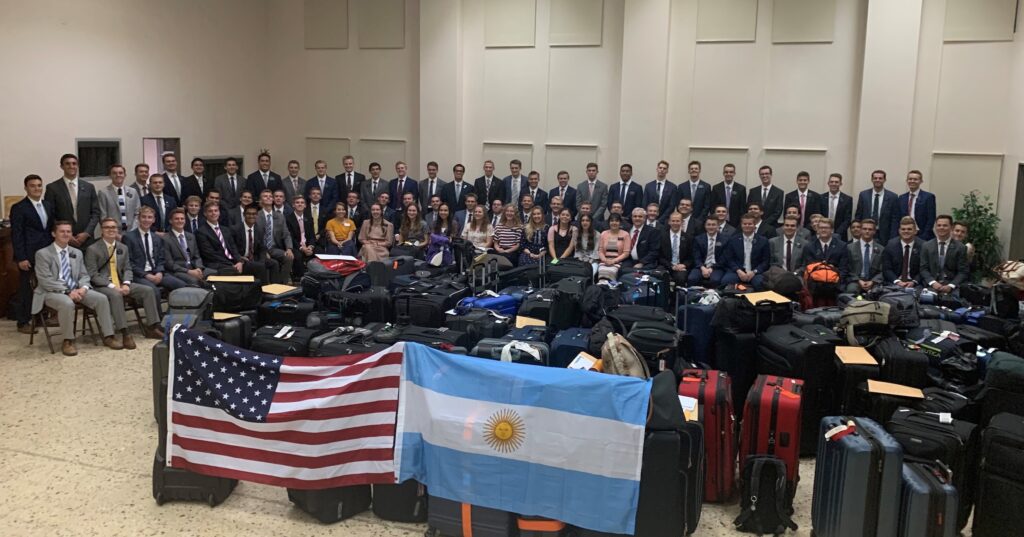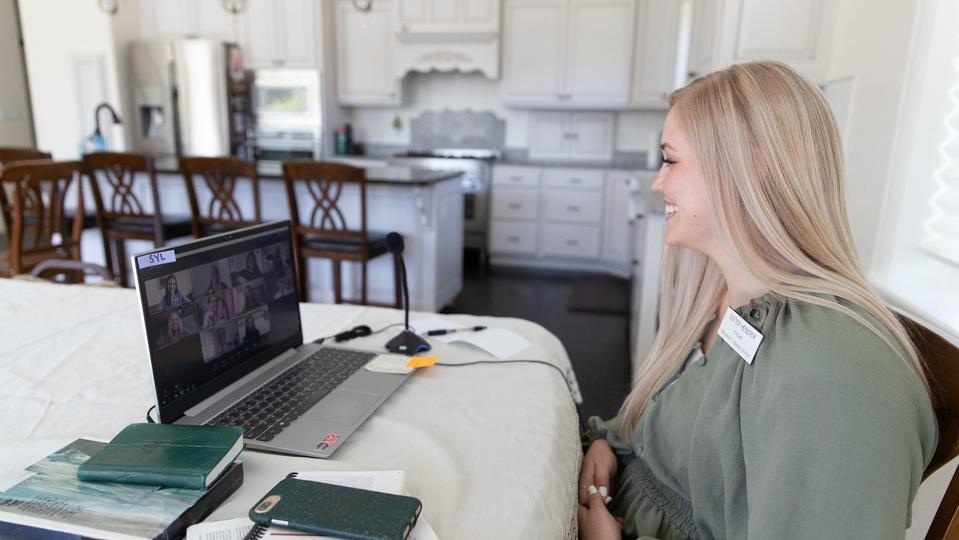By Cassidy Wixom
Editor’s note: This story appeared in the October 2021 edition of The Daily Universe Magazine.
The coronavirus swept the world beginning in 2019, altering life as we know it. National shutdowns, case outbreaks, overrun hospitals, millions of lost jobs, schools closed, digital everything and more. The world seemed to stop for months and now countries, governments, families, businesses, churches and more are trying to pick up the pieces and move forward into this new version of life.
The Church of Jesus Christ of Latter-day Saints was no exception to having its world rocked. Thousands of missionaries sent home in a matter of days. Temples closed with no projected date on when they would reopen. Weekly Church meetings disbanded until further notice. General Conference turned to digital streaming only.
Marriages were postponed, mission calls reassigned, Missionary Training Centers closed. Fulfilling callings became a little more challenging and uncertainty pervaded aspects of the Church causing many to wonder how it would recover and move forward with its work.
The question now is: has any good come from the massive disruptions the Church and the rest of the world went through?
Although the COVID-19 pandemic is far from over, The Daily Universe recently examined how the Church has been able to move forward and grow from the challenges of the last year and a half.
Approximately 19 months after the world shuttered to a halt, the Church is progressing forward again. The COVID-19 pandemic increased the Church’s use of technology, revolutionized missionary work, expanded family history efforts and reminded members of the importance of temples.
Weekly Church meetings have returned in some areas of the world although masks, vaccines and more protective measures are intertwined with worship now. Online scheduling, Zoom meetings and broadcasted devotionals have allowed messages, insights and gospel principles to still be shared across the Church.
Every single temple has reopened in some capacity allowing marriages, endowments and other sacred temple work to resume, but many temples are still limited on operations. Some missionaries who were reassigned to serve in their home countries are now being sent back to their original foreign assignments to continue serving through new technological-based methods.
Despite the challenges, President Russell M. Nelson never stopped guiding the Church and assuring members that the pandemic would end. During COVID-19, he continued announcing new temples, reopening current temples when he could, instating new callings, taking stands on social controversies and directing the Church in today’s ever-changing, unpredictable circumstances.
COVID-19 revolutionizes missionary work
By Jackson Payne
It was a grim scene at the airport in Buenos Aires.
Dazed and confused, more than 400 American missionaries representing five different missions crowded before sunrise waiting to evacuate Argentina. It was March 2020, and COVID-19 was at the forefront of the rapid unraveling of world normalcy. The mass exodus of missionaries spanned worldwide, with those serving in Africa, Asia, the Pacific and South and Central America being sent back to the states as quickly as possible.
Argentina’s missionaries were no different. After two days of quarantine, Connor Quinn, who had been serving in the Buenos Aires South Mission for eight months, was informed he and the rest of the American missionaries would be returning home — but with no specific timetable. Quinn and company languished in limbo for another week before receiving word they needed to be ready to leave in the next two hours.
“It was solemn,” Quinn said of the airport assembly. “It all happened so fast, we weren’t really prepared to leave. Personally, I was worried about what would come next, it was all very rushed.”
What came next for Quinn and thousands of other missionaries around the globe was an “inter-mission” period at home followed by a temporary stateside reassignment, helping to blaze the trail ahead for the most abrupt, yet expansive revolution in the history of missionary work.

Long gone were the days of tracting, door knocking and “hitting the pavement.” This core diet of missionary effort was turned upside down entirely by pandemic-induced regulations and prompted immediate adjustments. Most notably was an increased involvement of Church members and utilization of technology.
A year before the pandemic, Robby Gordon spent three months in the Florida Fort Lauderdale Mission waiting for his visa before heading to his original assignment in the Angola Luanda Mission. Once COVID-19 hit, Gordon was sent to Cincinnati on reassignment, giving him two unique stateside mission experiences before and throughout the pandemic.
“I never contacted on the street in Ohio, and I never messaged anyone digitally in Florida,” Gordon said. “You definitely reach more people with technology than just talking to people on the street.”
Gordon Treadway, former president of the Utah Orem Mission at the time of initial quarantine, recalled that while the pandemic had caught everyone by surprise, his mission was well-equipped to press forward in the unprecedented circumstances. “In some ways, the Lord had prepared us a lot more for the pandemic than we realized at the time.”
Missionaries in Orem had been piloting a “member missionary message” program for more than 18 months before the pandemic in which they met with members to teach brief lessons, update and excite them on the work and seek referral opportunities. The program, which Treadway dubbed “M3”, gave missionaries an immediate pursuit for excellence in the early days of COVID-19.
“Within a few days of lockdown, we had completely transitioned to online work,” Treadway said. “While some missions took a while to figure out how to stay productive, our mission was teaching 2,000-4,000 lessons a week through Zoom because we continued to work with the members to help us transition to working with our investigators.”
Zoom became a “new normal” for missions around the globe, helping missionaries reach individuals and families confined to their homes conveniently through a screen.
“Zoom opened missionary work in ways that it never would have happened otherwise,” BYU missionary preparation instructor Susie Mullen said.
The changes in missionary work led Susie Mullen and her husband and team teacher, Tom, to train their prospective missionary students on the new ways to spread the gospel. One example is utilizing the blended class format to teach role play lessons virtually.

“We had to pivot in how we taught,” Tom said. “It was the same principles and doctrine but a different application in a new normal. Having our students teach each other online over Zoom is something we didn’t do before COVID, so now they’re gaining experience that they’ll take with them.”
Susie added that while the message shared by missionaries remains the same — although more relevant in a pandemic-ridden world searching for peace — the new methods of sharing it requires proficiency in online abilities. “Teaching skills are different when you teach an older person compared to a 10-year-old, and it’s the same with online teaching compared to in–person.”
Other missions in Utah were quick to follow Orem’s lead, doubling their efforts on member-focused work to find the most effective course of action for missionary work during COVID-19. Quinn, reassigned to the Utah Salt Lake City Mission, noted the increased level of productivity that came with technology based teaching over Zoom. “Technology made our lessons much more effective, and a lot of that came from working with members,” he said.
Weston Ludlow was reassigned to serve in Provo after serving nine months in the Ecuador Quito Mission. He recalled that while technology wasn’t as strong of a focus in his mission, working with the members proved to pay great dividends in their missionary efforts, especially when teaching individuals with concerns.
Ludlow said missionary work is more efficient with referrals from members. “Everyone here have their prejudices (about the Church), but people know good members who can be examples, answer their questions and help them understand better.”
In Orem, Treadway said his missionaries saw a staggering increase in their key indicator totals from “M3” member referrals, with new investigators taught and baptism numbers more than doubling from August through October compared to the three months before the pandemic.
“The greatest blessing of the member initiative was that our missionaries had a daily purpose, and because of that, morale, focus and enjoyment among missionaries actually increased over the following months,” Treadway said. “They pushed forward because they had something to do all day every day. It can’t be understated how important it was to keep the missionaries engaged, involved and excited about the work even when they were stuck inside their apartments.”
The Orem mission also created “The Road to Hope and Peace” Facebook page in an attempt to dive into social media work, gaining more than 40,000 followers with daily posts of inspirational videos, member testimonies and other well-crafted content. Additionally, the page hosted weekly live devotionals over Facebook Watch with notable guests such as professional golfer Tony Finau, actor Kirby Heybourne and former BYU basketball star Jimmer Fredette.
The page has proven to be a worldwide referral machine with content being shared in more than 100 different countries. “We were able to find, teach and baptize people in at least three different continents as a result of our Facebook content,” Treadway said. “It was incredible to watch the impact that social media could have.”
Various countries have reopened their borders, allowing some missionaries to return to their original assignments and bring these improved missionary practices overseas. One such missionary was Quinn, who after 10 months in Salt Lake, was sent to spend his final months back in Argentina. He was quickly thrusted into the mission’s Facebook blitz as a content moderator to manage one of the mission’s four pages. Buenos Aires South has enjoyed tremendous success in its Facebook efforts, receiving more than 1,000 online referrals each month and perfecting the way new investigators are fellowshipped in their congregations.
“I learned in Salt Lake how to work with different organizations such as Relief Society and ward council, so going to Argentina with a Salt Lake model to follow and implement it there was a blessing,” Quinn said. “Preach My Gospel and statistics both show that working with members leads to more success, and I was able to integrate the people we taught better into the wards.”
Despite the commotion of COVID-19 and different mission changes, missionaries and leaders profess the continuation of miracles and God’s involvement in the work of salvation.
“The tools (in teaching) may be different, but you’ll see the same miracle of knowing that this is God’s work appear in each mission no matter where you are or how you do it,” Gordon said.
Missionaries like Quinn have come a long way since the Argentina airport chaos of the pandemic’s early days. Treadway credits the “COVID generation” of missionaries for being God’s chosen vessel to institute new and necessary changes in the work.
“Our missionaries came, embraced it fully and never complained,” Treadway said. “They did beautifully, and now all across the Church you’re hearing about how the work is more effective now than ever. That’s 100% a reflection of these missionaries and the truthfulness of Christ’s restored gospel.”

